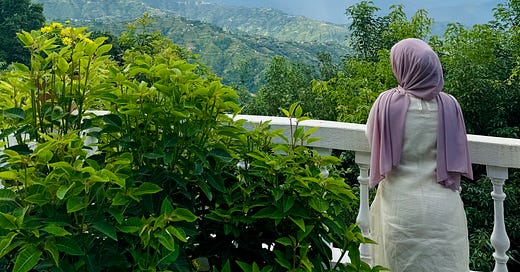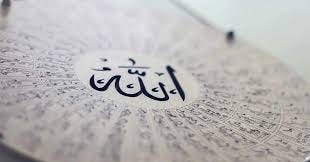The Patriarchal Ploy of the "Divine Feminine"/"Femininity"
Reclaiming the Divine Feminine and Masculine through an Islamic Lens
In the flickering mirror of modern spirituality, the language of “divine femininity” shimmers seductively; an alluring promise whispered across timelines, vision boards, and algorithmic scrolls. It speaks to a hunger, a longing to return to softness, to stillness, to something ancient and whole. For many, it is a balm offered to the weary soul, particularly to women fatigued by the sharp edges of modern life. This “divine feminine” offers women and girls “solutions” by placing the problem solely within them, diverting attention from systemic injustices and oppressive systems. My algorithm offers me little of such content, cautious as it is about disrupting the dopamine hits it curates for me, but I heard about this movement from a younger friend. Of course, I’d heard of this trend, but I hadn’t paid it much attention. Since she mentioned it though, I knew I wanted to return to this phenomenon.
The more I look, the more I see that beneath the silky veneer of rose quartz rituals, cycle-synching and lunar affirmations lies a troubling architecture. In its popular form, this movement often rests on the scaffolding of gender essentialism, carving human experience into neatly opposed binaries: the masculine as logical, forceful, and unyielding; the feminine as intuitive, receptive, and tender. Though cloaked in the language of liberation, such dichotomies echo the very patriarchal myths they claim/seek to transcend. They do not come anywhere near dismantling the edifice of gendered expectation; they gild it.
More disconcerting still is the way these “spiritual” prescriptions are offered not as invitations but imperatives: to be soft, to surrender, to “receive” as a woman. On a superficial level, it repackages “empowerment” in the best way capitalism knows; as a performance, an aesthetic, a self-help book/course/retreat for you to purchase your way back to your “power” as women. In this framework, divinity is filtered through branding, and wholeness becomes a subscription model; a pyramid scheme back to the patriarchy.
It’s important to note that these narratives do not emerge in isolation. They resonate with larger, more insidious political currents. In the Global North, particularly within conservative and ethno-nationalist discourses, we see a parallel fetishisation of traditional femininity. In the United States, the Trump administration has openly courted white women to fulfill a nationalistic imperative: to birth more babies for the sake of demographic control (this is not extended to Black and brown women, of course). In the United Kingdom, legislative moves against trans women, cloaked in the language of protection and authenticity (the fallacy of which is clearly and easily undermined with just a little probing as demonstrated by MP Bell Ribeiroaddy), reveal a deep discomfort with gender variance and a reinforcement of rigid gender norms.
These manoeuvres exemplify what the United Nations has recently termed “norm spoiling”: the deliberate attempt to undermine, reverse, or corrupt existing human rights norms, particularly those around gender, sexuality, and bodily autonomy. Norm spoiling is a strategic effort to fracture international consensus, sow confusion, and re-entrench patriarchal authority under the guise of cultural or national preservation. It manipulates the language of morality to roll back hard-won rights, packaging regressive politics as a return to order or tradition. The UN has formally recognised this trend as a serious global concern, marking it as a threat not just to marginalised groups, but to the integrity of international human rights frameworks as a whole.
Yet the Islamic mystical tradition, particularly in the cosmology of Ibn ‘Arabi, offers a deeper and more expansive terrain. Here, the Divine is not cleaved by gender, but radiates through illuminating Names of Allah; each a facet of the boundless One. These Names fall into resonant pairings: jalal (majesty) and jamal (beauty), often analogised as “masculine” and “feminine,” though such terms falter before the enormity of their meanings. Importantly, the jalali is described as masculine, but masculine does not mean man; and the jamali is feminine, but feminine does not mean woman. These terms gesture not toward social categories but toward divine qualities: energetic modes that coexist and cohere within every being.
As Sa'diyya Shaikh notes in her profound engagement with Ibn 'Arabi in her book Sufi Narratives of Intimacy: Ibn ‘Arabi, Gender and Sexuality, these Names are not gendered assignments but ontological archetypes. Jalali attributes speak of grandeur, might, and awe; jamali attributes evoke gentleness, mercy, and beauty. Interestingly, as Shaikh explains, Ibn ‘Arabi cautioned against an overemphasis on the jalali attributes, warning that human beings are far more likely to embody them in excess and thus risk falling into injustice. Because of this imbalance, he urged believers to lean toward the jamali, toward mercy, beauty, and love, as a spiritual safeguard and a closer approximation of divine harmony. Crucially, the path of spiritual maturation is not gendered: every seeker is called to harmonise these dimensions within themselves.
In this sacred geometry, femininity is not fragility assigned to women, and masculinity is not might assigned to men. Rather they are ways of being, both of which are essential. If embodied on their own, they lead to imbalance. Instead, a unique alchemy between the two is required for each of us in response to our natural or current constitutions. Both the jamali and the jalali are strands we must weave together in perfect balance, altering their amounts or volume as we recognise the weaknesses or opportunities for growth within ourselves.
Unlike the commodified landscapes of digital spirituality, the Islamic path does not infantilise nor essentialise. It does not flatter the ego but nor does it crush agency. It calls instead for inward undoing: tazkiyah (purification), dhikr (remembrance), and a slow becoming through reflecting upon and deeply engaging with the Names of God. Here, divine attributes are not brand strategies but moral imperatives. They are not disempowering slogans, but sources of spiritual nourishment that give Believers the strength, wisdom, agency and insight to act.
In a world eager to shrink the soul into slogans, this tradition invites us to stretch, to deepen, to remember. To see beyond the binary, and into the multiplicity of qualities and states of being reflected to us in the Names of Allah, where the Divine is not split, but whole and powerful. And so, too, are we.
Ways You Can Support My Work
Buy one of my books and/or leave a review for one if you already have it.
Subscribe to my newsletter, Meanings in the Margins.
Share this newsletter with someone you think would benefit from reading it.
Event Announcement
Empowered by Aisha, Mother of the Believers hosted by Northwood Muslims and Friends. Saturday 24th May, 2:00pm Northwood. All proceeds will be going to charities in Gaza and Pakistan.
Check out my Surah al-Mulk Tafsir Course.
Find me elsewhere:
Website: www.sofiarehman.co.uk
Socials: Instagram | Patreon |





Well penned, Dr. Sofia. Both men and women are being dished out the same slop in different colors. Red pill alpha chad nonsense used for guys and this divine femininity or twisted trad femininity stuff for women. It seems to work in the same way as the fallacy of meritocracy, “if you’re poor, you just need to work harder.” The onus for growth is pushed onto the individual when the very soil is poisoned and rancid.
I like the jalali and jamali terminology. Never heard of it before, but makes very intuitive sense. If anyone pauses for a moment and reflects on the seerah, it becomes abundantly clear that both genders can embody these qualities as needed, and the manifestation of the qualities can look the same or different. That is not to say we don’t have a fitrah and general gendered qualitative tendencies. Both of these things can be simultaneously be true. All of these black/white divides are just extremes, and ours is not a deen of polarity.
A question: I did not understand the point you were trying to make regarding transwomen. I watched the clip (but she was talking about transmen?), and the bathroom situation is a messy one. Predators will still prey upon the vulnerable under any policy, namely children and women. If you can, could you elaborate a bit on your point and how it ties into your broader thesis?
One last thing, I never understood why everyone was hating on “the patriarchy.” The word to me only meant a society where men are mainly in power. I very earnestly thought that the khilafah rashidah and the prophet PBUH’s leadership was a patriarchy. Clearly that’s not what the modern term means as I’ve come to learn (or I’m still trying to figure it out). So another question for you, what’s a word/term/phrase we can use to talk about the way we see men in power in the seerah? Surely the prophet PBUH is uswatun hasanah, so what language can we use to differentiate between the problematic and oppressive patriarchy vs the just and moral patriarchy we see in the prophet PBUH’s time and the khilafah rashidah?
Apologies for the very long comment😅
Salaam Sofia, I loved reading this piece, thank you for your insight into this topic. Something that has always confused me is why Jalali and Jamali are described as masculine and feminine respectively. Do you know where this comes from? Or would you be able to point me in a direction where I can read into more of why they’ve been linked to masculine and feminine. Thank you!